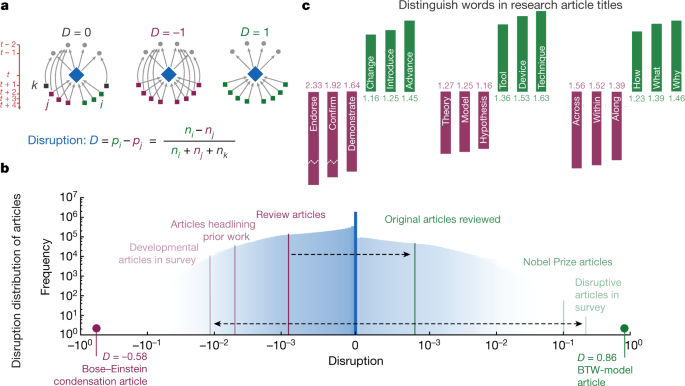
Guimerà, R., Uzzi, B., Spiro, J. & Amaral, L. A. N. Team assembly mechanisms determine collaboration network structure and team performance. Science 308, 697–702 (2005).
Wuchty, S., Jones, B. F. & Uzzi, B. The increasing dominance of teams in production of knowledge. Science 316, 1036–1039 (2007).
Hunter, L. & Leahey, E. Collaborative research in sociology: trends and contributing factors. Am. Sociol. 39, 290–306 (2008).
Jones, B. F., Wuchty, S. & Uzzi, B. Multi-university research teams: shifting impact, geography, and stratification in science. Science 322, 1259–1262 (2008).
Xie, Y. “Undemocracy”: inequalities in science. Science 344, 809–810 (2014).
Milojević, S. Principles of scientific research team formation and evolution. Proc. Natl Acad. Sci. USA 111, 3984–3989 (2014).
Falk-Krzesinski, H. J. et al. Mapping a research agenda for the science of team science. Res. Eval. 20, 145–158 (2011).
Committee on the Science of Team Science. Enhancing the Effectiveness of Team Science (National Academies Press, Washington DC, 2015).
Leahey, E. From sole investigator to team scientist: trends in the practice and study of research collaboration. Annu. Rev. Sociol. 42, 81–100 (2016).
Paulus, P. B., Kohn, N. W., Arditti, L. E. & Korde, R. M. Understanding the group size effect in electronic brainstorming. Small Group Res. 44, 332–352 (2013).
Lakhani, K. R. et al. Prize-based contests can provide solutions to computational biology problems. Nat. Biotechnol. 31, 108–111 (2013).
Barber, S. J., Harris, C. B. & Rajaram, S. Why two heads apart are better than two heads together: multiple mechanisms underlie the collaborative inhibition effect in memory. J. Exp. Psychol. Learn. Mem. Cogn. 41, 559–566 (2015).
Minson, J. A. & Mueller, J. S. The cost of collaboration: why joint decision making exacerbates rejection of outside information. Psychol. Sci. 23, 219–224 (2012).
Greenstein, S. & Zhu, F. Open content, Linus’ law, and neutral point of view. Inf. Syst. Res. 27, 618–635 (2016).
Christensen, C. M. The Innovator’s Dilemma: The Revolutionary Book That Will Change the Way You Do Business (Harper Business, New York, 2011).
Klug, M. & Bagrow, J. P. Understanding the group dynamics and success of teams. R. Soc. Open Sci. 3, 160007 (2016).
Bak, P., Tang, C. & Wiesenfeld, K. Self-organized criticality: an explanation of the 1/f noise. Phys. Rev. Lett. 59, 381–384 (1987).
Davis, K. B. et al. Bose–Einstein condensation in a gas of sodium atoms. Phys. Rev. Lett. 75, 3969–3973 (1995).
Bose, S. N. Plancks Gesetz und Lichtquantenhypothese. Z. Physik 26, 178–181 (1924).
Einstein, A. Quantentheorie des einatomigen idealen Gases. Sitzungsberichte der Preussischen Akademie der Wissenschaften 1, 3 (1925).
March, J. G. Exploration and exploitation in organizational learning. Organ. Sci. 2, 71–87 (1991).
Funk, R. J. & Owen-Smith, J. A dynamic network measure of technological change. Manage. Sci. 63, 791–817 (2017).
Moody, J. The structure of a social science collaboration network: disciplinary cohesion from 1963 to 1999. Am. Sociol. Rev. 69, 213–238 (2004).
Ke, Q., Ferrara, E., Radicchi, F. & Flammini, A. Defining and identifying Sleeping Beauties in science. Proc. Natl Acad. Sci. USA 112, 7426–7431 (2015).
Wang, D., Song, C. & Barabási, A.-L. Quantifying long-term scientific impact. Science 342, 127–132 (2013).
Evans, J. A. Electronic publication and the narrowing of science and scholarship. Science 321, 395–399 (2008).
Gerow, A., Hu, Y., Boyd-Graber, J., Blei, D. M. & Evans, J. A. Measuring discursive influence across scholarship. Proc. Natl Acad. Sci. USA 115, 3308–3313 (2018).
Uzzi, B., Mukherjee, S., Stringer, M. & Jones, B. Atypical combinations and scientific impact. Science 342, 468–472 (2013).
Kuhn, T. S. The function of measurement in modern physical science. Isis 52, 161–193 (1961).
Collins, D. Organizational Change: Sociological Perspectives (Routledge, New York, 1998).
Jones, B. F. The burden of knowledge and the ‘death of the Renaissance man’: is innovation getting harder? Rev. Econ. Stud. 76, 283–317 (2009).
Alcácer, J., Gittleman, M. & Sampat, B. Applicant and examiner citations in U.S. patents: an overview and analysis. Res. Policy 38, 415–427 (2009).
Schulz, C., Mazloumian, A., Petersen, A. M., Penner, O. & Helbing, D. Exploiting citation networks for large-scale author name disambiguation. EPJ Data Sci. 3, 11 (2014).
Mutz, R., Bornmann, L. & Daniel, H.-D. Cross-disciplinary research: What configurations of fields of science are found in grant proposals today? Res. Eval. 24, 30–36 (2015).
Le, Q. & Mikolov, T. Distributed representations of sentences and documents. In Proc. 31st International Conference on Machine Learning (eds Xing, E. P. & Jebara, T.) 1188–1196 (PLMR, Beijing, 2014).
Correia, S. A feasible estimator for linear models with multi-way fixed effects. Preprint at http://scorreia.com/research/hdfe.pdf (2016).
Full text of Alfred Nobel’s will, available at https://www.nobelprize.org/alfred-nobel/full-text-of-alfred-nobels-will/ (accessed 25 September 2018).
Bagikan Berita Ini
















0 Response to "Large teams develop and small teams disrupt science and technology - Nature.com"
Post a Comment